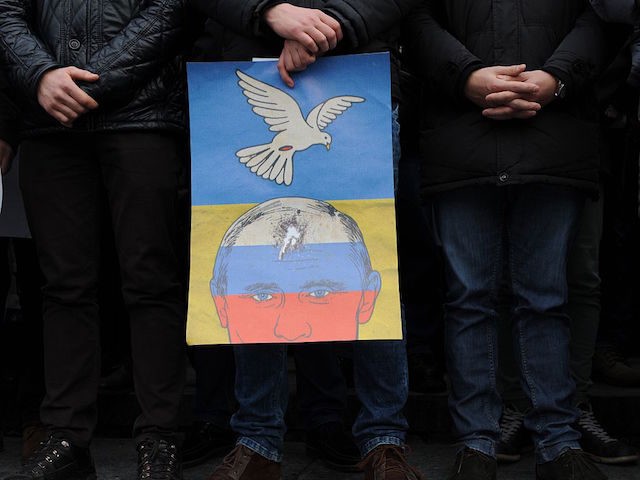The strategy of popular revolts has expired in Venezuela. No protest alone can succeed against a leftist regime that has no problem using its firepower against anybody.
With Vladimir Putin’s Russia – a seasoned repressor of peaceful protest – Maduro boasts a formidable resource in how to strategically take out the opposition.
Russians have been advising Maduro, teaching him how to crush the “color revolution” strategy interim President Juan Guaidó has enacted, for a long time now.
Guaidó announced Tuesday that the “final phase” in removing Maduro, “Operation Liberty,” had begun and that he needed civilians to flood the streets indefinitely for it to succeed.
Guaidó took over Altamira’s overpass with his socialist party’s leader, Leopoldo López, and several National Guard officials at 4 a.m. this Tuesday to announce “Operación Libertad.” After asking the military and civilians to join him at the gates of La Carlota airbase, massive repression started and lasted all morning until midday with no transcendence of the conflict.
Shootings between both forces were the climax, but the operation never really took off since military nerve points in Caracas and Maracay were under Maduro’s command. Later on, La Carlota opened its gates for a short moment with no rebel takeover.
The afternoon came and protestors gathered with military rebels at Altamira Square. People started marching in Eastside Caracas (chavismo’s stronghold) towards Miraflores but could not pass through the regime’s repression at Francisco de Miranda Avenue. Later on, Minister of Defense Vladimir Padrino López denounced a “coup” on national TV and threatened to use weapons “if necessary.”
Guaidó clearly followed the formula of a “spring” – like the ones that sent the Arab world into chaos this decade – or a “color revolution.”
The success of this form of popular revolt is reliant upon the people failing to relent, keeping pressure on the streets, but also upon the uprising simply having enough people organized to out-stamina the ruling power.
So far, Guaidó has not proven he has that kind of support – while Maduro relies on the game plan of one of the most successful repressors in the world.
Leaders throughout Eurasia – in Georgia, Ukraine, and Kyrgyzstan – similarly called for popular peaceful protests to expel pro-Putin leaders at the turn of the century. They achieved their goals for a time. Mikheil Saakashvili’s tenure as president of Georgia is perhaps most telling on how their story ended. As president, Saakashvili endured a brutal invasion by Putin’s forces in 2008 – a test drive for what would come later in Ukraine – before yielding office to a pro-Putin leader, attempting to help the Orange Revolution in Ukraine, and eventually being stripped of both Georgian and Ukrainian citizenship by Putin puppets. He now lives in Amsterdam, demanding the countries he served take him back without imprisoning him for his activism against Putin.
The lesson from Saakashvili’s exile is that, while these “color revolutions” may be inspiring, they all have one enemy: time. People cannot march for 24 hours or more, and frankly, no march and no strike in Venezuela can topple a regime of communist druglords and killers who have paramilitary groups and the army’s firepower under their command (even more so when Venezuelans are exhausted due to all the hunger and blackouts).
One of Russia’s key bits of advice to Maduro must be: Time is gold. Tire the population. Play with the enemy’s mind and fool them whenever you have the chance.
Time began taking its toll as quickly as Tuesday evening for Guaidó.
25 rebel soldiers who supported Guaidó asked for asylum at the Brazilian Embassy and López went to the Chilean Embassy and later to the Spanish, where still he remains. As of today, Maduro remains in power – thanks, according to Secretary of State Mike Pompeo, to the Russians.
Then came the violence: at least four dead since Tuesday, hundreds injured. People crushed by armored vehicles driven by Maduro’s soldiers.
This is not the first time that Leopoldo López’s party tries, and fails, to use this tactic, crushed by leftist violence. In this context, one of the best arguments against colored or spring revolutions is, exactly, color or spring revolutions. In the uprising we lived in 2014, with no weapons, known for big marches and clashes inspired by Gene Sharp’s manual, there were four times more injuries than the 2014 Ukranian revolution —and they got rid of their government.
The dictatorship has shown its willingness to engage in a high-level armed conflict. They are aware of what needs to be done to maintain the regime and they have played their cards well —they even seemingly made National Security Advisor John Bolton think a bunch of assassins and druglords could cooperate with the U.S.!
And Maduro has yet to use the full force of his resources. Let’s remember Venezuela is plagued with narco-terrorist groups such as ELN and FARC (at least in 40 percent of the territory), with Hezbollah cells, regime-financed gangs with war weaponry (colectivos), and Russian troops.
What needs to be done, considering all these elements, is not another “spring” or color revolution. This is an asymmetric war. Venezuelans are defending themselves with the weapons and ammo that are available, while colectivos, the socialist gangs Maduro uses to terrorize dissidents, have AR-15s and AKs.
Guaidó’s playbook, as it stands, is using Venezuelans as bait. With no weapons and nothing more than bodies on the streets, now is not the time for soft power. It’s time for a “smart power” strategy.
Rafael Valera is the Communications Director of the Venezuelan conservative movement Rumbo Libertad.

COMMENTS
Please let us know if you're having issues with commenting.